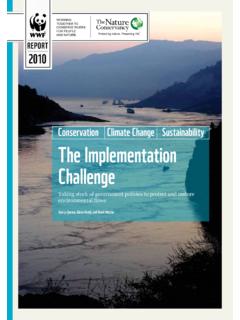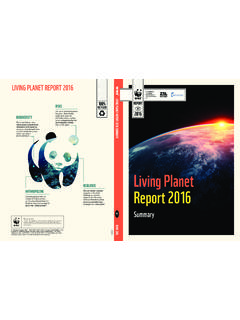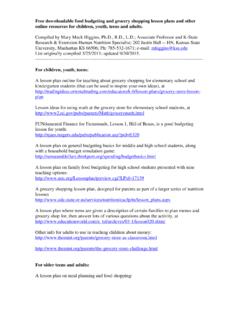Transcription of How to reduce paper consumption in your office
1 Interested to feature your paper reduction success on WWFs website? Please write to with a description of your paper saving programme and the reductions you were able to achieve. 1 How to reduce paper consumption in your office (and save money at the same time!) There are many easy ways for businesses and organizations to reduce their paper use and costs. Reductions of 20 percent or more are possible in most offices. Here are practical tips to help your company implement a cost-saving, paper reduction program: 1) Think before you print It is simply too easy to push the print-button. For example, much paper is wasted by printing out single line emails or printing out unnecessary copies of documents.
2 Departments should carefully assess their needs before ordering bulk print copies of information materials, like annual reports or brochures. In many cases hundreds if not thousands of un-used copies end up in storage rooms clogging up storage space. The golden rule of saving paper : Think twice if you really need to print if it is necessary to print make sure you print on both sides (duplex). This is a really easy way to reduce paper consumption by half. Easy ways to reduce wasteful paper use: a) Post in-house reminders near the copy machine or at individual desktops. Use catchy slogans, for example: Do you really need to print that?
3 Or Do you know how many sheets of paper you used last month? WWF has created some eye-catching posters with such messages. Download at b) Track the personal printing footprint in your office Create systems that allow staff to measure how many print copies they are personally responsible for each month. Most people are shocked to find out their individual cumulative number of copies. This knowledge will motivate people to reduce their personal paper footprint. Interested to feature your paper reduction success on WWFs website? Please write to with a description of your paper saving programme and the reductions you were able to achieve.
4 2 By tracking individual printing quantities, staff will be able to measure changes over time. One way to promote less printing is by running in-house competitions for paper Saving Champion of the month who printed the least copies. c) reduce print runs Undergo an inventory to identify past printing jobs for which too many copies were ordered. This will help ensure that the quantity ordered matches demand for printing jobs in the future. Publicize the results of your inventory in-house, for example on your office notice board or in your company newsletter, and encourage people to be more mindful of the number of copies ordered. Create a checklist for those departments which order informational materials.
5 The checklist should include question such as: Please identify the target group for the brochure. Verify the number of required recipients and the number of back-up copies needed. Are you sure these target groups will need a hard copy of the report or is it enough to point them to a website? Do they need to be proactively sent the hard copy or is it sufficient to make it available upon request? Do you need in-house copies for all staff or can copies be held in communal areas/on notice boards? How many reserve copies do you require and why - for what events or purposes? Who will distribute or oversee the distribution of the reserve copies?
6 Simply by addressing these questions, it is highly likely that the quantity of future print runs will be more realistic. d) Review distribution lists frequently. Eliminate outdated or unnecessary recipients. See if destinations with many recipients can make do with fewer copies. e) Conduct paper -less meetings When you hold a meeting, do you really need to have hard copies of preparatory materials available for each participant? Encourage people to use their computers for reviewing documents and note-making Interested to feature your paper reduction success on WWFs website? Please write to with a description of your paper saving programme and the reductions you were able to achieve.
7 3 Make sure meeting participants have electronic access to all the materials beforehand encourage those using computers not to print out copies. If you must supply additional materials at the meeting, consider burning CDs for all participants. Make copies as needed rather than in large batches at one time. Frequently, extra copies of important internal documents become outdated quickly and only end up being discarded. Making copies as needed can reduce this problem significantly. 2) Use paper more efficiently Duplexing, copying images onto both sides of a sheet of paper , can save up to 50% of paper costs. Duplexing saves money on paper purchasing, as well as on storage and mailing.
8 Duplex copies are also easier to fold and staple. While some prints and copies need to be single-sided, most do not. a) Set defaults on computers Set defaults to double sided - select one-sided printing only when really needed. Print double-sided for bills, applications, licenses, and other paper -intensive activities. For help how to set default settings see If your printer cannot double-side then find out whether your printer can be fitted with a duplexing unit to enable it to print double sided. b) Change your computer s default settings so that you can put more text on each page. In MS Word, go to File, then to Page Setup. Then choose reduce the Margins and set your margins to smaller numbers.
9 Compared to the normal settings, you could use up to 14% less paper ! When you are printing, reduce font size to 10 point to decrease the amount of paper required. c) Post in-house reminders about efficient paper use near the copy machine and/or each workstation Use both sides of the sheet of paper , whether for copying or printing. Print only the pages you need by using the Print Selection function. Print documents 2-UP OR 4-UP per page for archival purposes and where possible. Customized software can increase the document-per-page capabilities of your printer. reduce margins. Interested to feature your paper reduction success on WWFs website?
10 Please write to with a description of your paper saving programme and the reductions you were able to achieve. 4 Use the print preview function before printing any word or excel document to avoid copy-mistakes. Use a small font size to reduce the number of pages printed Use efficient fonts like Times New Roman or Arial these fonts use significantly less space. See: d) Use your fax effectively: Send a fax or word document without printing first! Simply use the menus in Word: choose File, then Send to, then Fax recipient, and then follow the instructions. This allows faxes to be sent from computers without the need to print first. Also allows faxes to be received in an e mail rather than printed copy format.
















